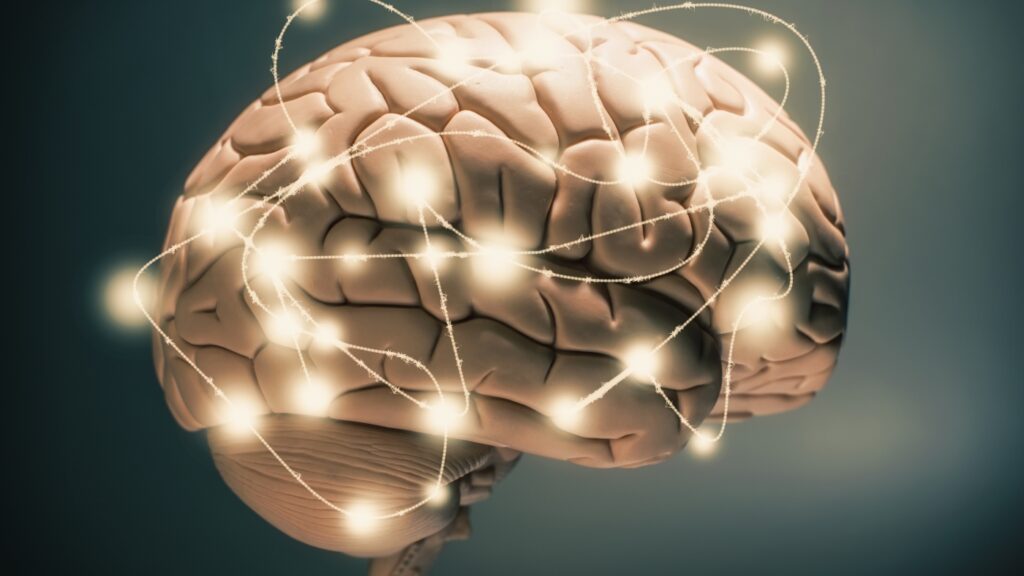Growing old and Alzheimer’s go away the mind starved of power. Now scientists assume they’ve discovered a technique to support the mind’s metabolism — in mice.
PM Pictures/Getty Pictures
conceal caption
toggle caption
PM Pictures/Getty Pictures
The mind wants a number of power — way over every other organ within the physique — to work correctly. And getting old and Alzheimer’s illness each appear to go away the mind underpowered.
However an experimental most cancers drug appeared to re-energize the brains of mice that had a type of Alzheimer’s — and even restore their skill to study and keep in mind.
The discovering, revealed within the journal Science, means that it might finally be potential to reverse some signs of Alzheimer’s in folks, utilizing medicine that enhance mind metabolism.
The outcomes additionally supply an strategy to remedy that’s in contrast to something available on the market at present. Present medicine for treating Alzheimer’s, comparable to lecanemab and donanemab, goal the sticky amyloid plaques that construct up in a affected person’s mind. These medicine can take away plaques and gradual the illness course of, however don’t enhance reminiscence or considering.
The outcome ought to assist “change how we take into consideration concentrating on this illness,” says Shannon Macauley, an affiliate professor on the College of Kentucky who was not concerned within the examine.
A shock, then a discovery
The brand new analysis was prompted by a lab experiment that didn’t go as deliberate.
A group at Stanford was finding out an enzyme known as IDO1 that performs a key position in protecting a cell’s metabolism working correctly. They suspected that in Alzheimer’s illness, IDO1 was malfunctioning in a manner that restricted the mind’s skill to show vitamins into power.
So the group used genetics to remove the enzyme fully from mice that develop a type of Alzheimer’s. They figured that with none IDO1, mind metabolism would decline.
“We anticipated to see every part [get] a lot, a lot, a lot worse”, says Dr. Katrin Andreasson, a professor of neurology and neuroscience at Stanford. “However no, it was the exact opposite.”
With out the enzyme, the mouse brains have been truly higher at turning glucose into power and didn’t exhibit the reminiscence loss normally related to Alzheimer’s.
“It was such a profound rescue that we kind of went again to the drafting board and tried to determine what was occurring,” Andreasson says.
Finally, the group discovered a proof.
Eliminating the enzyme had altered the conduct of cells known as astrocytes.
Normally, astrocytes assist present power to neurons, the cells that permit for studying and reminiscence. However when the poisonous plaques and tangles of Alzheimer’s start to look within the mind, ranges of IDO1 rise and astrocytes cease doing this job.
“They’re form of put to sleep,” Andreasson says. So “you’ve bought to wake them as much as get them to assist the neurons.”
And that’s what occurred when scientists used genetics to take away IDO1.
Their speculation was that prime ranges of IDO1 have been limiting the astrocytes’ skill to supply lactate, a chemical that helps mind cells, together with neurons, rework meals into power.
To verify the speculation, the group, led by Dr. Paras Minhas, did a sequence of experiments. One concerned inserting a mouse within the heart of a shiny white disk below a vivid gentle.
“It actually desires to get out of there,” Andreasson says. “Nevertheless it has to study the place the escape gap is” by following visible cues.
Wholesome mice realized easy methods to learn these cues after a number of days of coaching, and would escape nearly immediately.
“However within the Alzheimer mice, the time to seek out the escape gap actually skyrocketed,” Andreasson says.
That modified when the group gave these mice an experimental most cancers drug that might block the enzyme a lot the way in which genetic engineering had.
The handled mice realized to flee the intense gentle as rapidly as wholesome animals. And a have a look at their brains confirmed that their astrocytes had woken up and have been serving to neurons produce the power wanted for reminiscence and considering.
Within the hippocampus, a mind space that’s vital for reminiscence and navigation, assessments confirmed that the drug had restored regular glucose metabolism despite the fact that the plaques and tangles of Alzheimer’s have been nonetheless current.
The group additionally examined human astrocytes and neurons derived from Alzheimer’s sufferers. And as soon as once more, the drug restored regular operate.
Past plaques and tangles
The experiments add to the proof that Alzheimer’s entails much more than simply the looks of plaques and tangles.
“We will have these metabolic adjustments in our mind,” Macaulay says, “however they’re reversible.”
Neurons have lengthy been the main target of Alzheimer’s analysis. However the brand new outcomes additionally present how other forms of cells within the mind can play an vital position within the illness.
The mind is a bit like a beehive, the place a neuron is the queen, Macaulay says. However she’s stored alive by employee bees, like astrocytes, that are requested to do extra as Alzheimer’s adjustments the mind.
“These employee bees are getting unbelievably taxed from all of the issues they’re being requested to do,” Macaulay says. “When that occurs, then the entire system doesn’t work properly.”
Metabolic therapies that restore astrocytes and different helper cells within the mind may sometime increase present Alzheimer’s medicine that take away amyloid plaques, Macauley says.
And the metabolic strategy could possibly enhance reminiscence and considering — one thing amyloid medicine don’t do.
“Perhaps this will make your astrocytes and your neurons work slightly bit higher, so that you simply operate slightly bit higher,” Macaulay says.
However first, she says, the promising outcomes must be replicated in folks.


